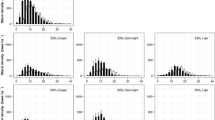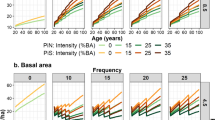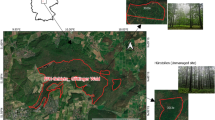Abstract
Growth responses to thinning can vary with site quality and age, however, the direction of the response varies. An understanding of the mechanisms behind thinning responses could help forest managers optimise production as well as inform modellers and ecologists about the functioning of tree stands. Thinning was used to create a range of stand densities in eleven Eucalyptus plantation stands on seven sites in south-eastern Australia. Basal area periodic annual increment (PAI; cm2 year−1) of individual dominant and codominant trees was then related to competition, such that PAI = a + b ln(Competition). Competition was defined as the sum of the basal area of neighbouring trees within a radius of 6.5 m. The relative (%) and absolute (cm2 year−1) responses to competition were quantified using b, which was correlated with site quality and stand structure of unthinned stands. Stand structure was quantified using statistics or parameters that describe the diameter distribution for the given age, species and site, including skewness, the coefficient of variation and parameters of the Weibull probability distribution. Relative and absolute responses both increased with increasing site quality and in stands with more negatively skewed diameter distributions (higher proportion of larger trees) or lower coefficients of variation. Absolute thinning responses often increased with increasing size class, while relative thinning responses often decreased. Variables describing diameter distributions (size-class structure) were able to describe some of the variation in competition responses that site quality could not. This indicates why stands on similar site qualities but with different stand structures can have correspondingly different thinning responses. Stand structural variables may be more useful predictors of thinning responses in stands that experience large temporal changes in diameter distributions compared with site quality, which is a more static variable. Thus, knowledge about the development of diameter distributions might help to refine thinning regimes.





Similar content being viewed by others
References
Álvarez González JG, Schröder J, Rodríguez Soalleiro R, Ruíz González AD (2002) Modelling the effect of thinnings on the diameter distribution of even-aged Maritime Pine stands. For Ecol Manag 165:57–65
Biging GS, Dobbertin M (1992) A comparison of distance-dependent competition measures for height and basal area growth of individual conifer trees. For Sci 38:695–720
Blevins DP, Prescott CE, Allen HL, Newsome TA (2005) The effects of nutrition and density on growth, foliage biomass, and growth efficiency of high-density fire-origin lodgepole pine in central British Columbia. Can J For Res 35:2851–2859
Bréda N, Granier A, Aussenac G (1995) Effects of thinning on soil and tree water relations, transpiration and growth in an oak forest (Quercus petraea (Matt.) Liebl.). Tree Physiol 15:295–306
Brockley RP (2005) Effects of post-thinning density and repeated fertilization on the growth and development of young lodgepole pine. Can J For Res 35:1952–1964
Campoe OC, Stape JL, Nouvellon Y, Laclau JP, Bauerle WL, Binkley D, Maire GL (in press) Stem production, light absorption and light use efficiency between dominant and non-dominant trees of Eucalyptus grandis across a productivity gradient in Brazil. For Ecol Manag. doi:10.1016/j.foreco.2012.07.035
Corral Rivas JJ, Álvarez González JG, Aguirre O, Hernández J (2005) The effect of competition on individual tree basal area growth in mature stands of Pinus cooperi Blanco in Durango (Mexico). Eur J For Res 124:133–142
Costa e Silva J, Hardner C, Tilyard P, Pires AM, Potts BM (2010) Effects of inbreeding on population mean performance and observational variances in Eucalyptus globulus. Ann For Sci 67:605
Forrester DI, Baker TG (2012) Growth responses to thinning and pruning in Eucalyptus globulus, Eucalyptus nitens, and Eucalyptus grandis plantations in southeastern Australia. Can J For Res 42:75–87
Forrester DI, Medhurst JL, Wood M, Beadle CL, Valencia JC (2010) Growth and physiological responses to silviculture for producing solid-wood products from Eucalyptus plantations: an Australian perspective. For Ecol Manag 259:1819–1835
Forrester DI, Vanclay JK, Forrester RI (2011) The balance between facilitation and competition in mixtures of Eucalyptus and Acacia changes as stands develop. Oecologia 166:265–272
Forrester DI, Collopy JJ, Beadle CL, Baker TG (2012a) Interactive effects of simultaneously applied thinning, pruning and fertiliser application treatments on growth, biomass production and crown architecture in a young Eucalyptus nitens plantation. For Ecol Manag 267:104–116
Forrester DI, Collopy JJ, Beadle CL, Warren CR, Baker TG (2012b) Effect of thinning, pruning and nitrogen fertiliser application on transpiration, photosynthesis and water-use efficiency in a young Eucalyptus nitens plantation. For Ecol Manag 266:286–300
Forrester DI, Collopy JJ, Beadle CL, Baker TG (in press) Effect of thinning, pruning and nitrogen fertiliser application on light interception and light-use efficiency in a young Eucalyptus nitens plantation. For Ecol Manag. doi:10.1016/j.foreco.2011.11.024
Grosser C, Potts BM, Vaillancourt RE (2010) Microsatellite based paternity analysis in a clonal Eucalyptus nitens seed orchard. Silvae Genet 59:57–62
Hara T (1993) Mode of competition and size-structure dynamics in plant communities. Plant Species Biol 8:75–84
Harrington CA, Wierman CA (1990) Growth and foliar nutrient response to fertilization and precommercial thinning in a coastal western red cedar stand. Can J For Res 20:764–773
Isbell R (2002) The Australian Soil Classification, Revised Edition. CSIRO Publishing, Melbourne
Kellomäki S, Väisänen H (1997) Modelling the dynamics of the forest ecosystem for climate change studies in the boreal conditions. Ecol Model 97:121–140
Kikuzawa K, Umeki K (1996) Effect of canopy structure on degree of asymmetry of competition in two forest stands in northern Japan. Ann Bot 77:565–571
Kolb TE, Agee JK, Fule PZ, McDowell NG, Pearson K, Sala A, Waring RH (2007) Perpetuating old ponderosa pine. For Ecol Manag 249:141–157
La Sala AV (2006) Pre-commercial thinning and fertiliser enhance growth in young native Eucalyptus obliqua (L’Hérit.) stands in Tasmania. Aust For 69:16–24
Lasch P, Badeck F-W, Suckow F, Lindner M, Mohr P (2005) Model-based analysis of management alternatives at stand and regional level in Brandenburg (Germany). For Ecol Manag 207:59–74
Mäkinen H, Isomäki A (2004a) Thinning intensity and growth of Scots pine stands in Finland. For Ecol Manag 201:311–325
Mäkinen H, Isomäki A (2004b) Thinning intensity and long-term changes in increment and stem form of Norway spruce trees. For Ecol Manag 201:295–309
Medhurst JL, Beadle CL, Neilsen WA (2001) Early-age and later-age thinning affects growth, dominance, and intraspecific competition in Eucalyptus nitens plantations. Can J For Res 31:187–197
Messina MG (1992) Response of Eucalyptus regnans F. Muell. to thinning and urea fertilization in New-Zealand. For Ecol Manag 51:269–283
Monserud RA, Sterba H (1996) A basal area increment model for individual trees growing in even- and uneven-aged forest stands in Austria. For Ecol Manag 80:57–80
Moore JA, Zhang L, Newberry JD (1994) Effects of intermediate silvicultural treatments on the distribution of within-stand growth. Can J For Res 24:398–404
Nord-Larsen T, Cao QV (2006) A diameter distribution model for even-aged beech in Denmark. For Ecol Manag 231:218–225
Omule AY, Mitchell AK, Wagner WL (2011) Fertilization and thinning effects on a Douglas-fir ecosystem at Shawnigan Lake: 32-year growth response Natural Resources Canada, Canadian Forest Service, Pacific Forestry Centre, Victoria, BC. Information Report FI-X-005., p 22
Peng C (2000) Growth and yield models for uneven-aged stands: past, present and future. For Ecol Manag 132:259–279
Pretzsch H (2009) Forest dynamics, growth and yield. Springer, Berlin, Heidelberg, 664 p
Pukkala T, Miina J, Kellomäki S (1998) Response to different thinning intensities in young Pinus sylvestris. Scand J For Res 13:141–150
Ruha T, Varmola M (1997) Precommercial thinning in naturally regenerated Scots Pine stands in northern Finland. Silva Fennica 31:401–415
Schröder J, Gadow KV (1999) Testing a new competition index for Maritime pine in northwestern Spain. Can J For Res 29:280–283
Schröder J, Soalleiro RR, Alonso GV (2002) An age-independent basal area increment model for maritime pine trees in northwestern Spain. For Ecol Manag 157:55–64
Simard SW, Blenner-Hassett T, Cameron IR (2004) Pre-commercial thinning effects on growth, yield and mortality in even-aged paper birch stands in British Columbia. For Ecol Manag 190:163–178
Stackpole DJ, Duncan MJ, Smith MJ, Baker TG (2004) Value-added silvicultural regimes for high quality timber production from intensively managed hardwood and softwood plantations, PN97.602 FaWPRaDC (ed) Forest Science Centre, Department of Sustainability and Environment, Melbourne, pp 55
Stoneman GL, Crombie DS, Whitford K, Hingston FJ, Giles R, Portlock CC, Galbraith JH, Dimmock GM (1996) Growth and water relations of Eucalyptus marginata (jarrah) stands in response to thinning and fertilization. Tree Physiol 17:267–274
Vanclay JK (2006) Spatially-explicit competition indices and the analysis of mixed-species plantings with the Simile modelling environment. For Ecol Manag 233:295–302
Wang W, Peng C, Zhang SY, Zhou X, Larocque GR, Kneeshaw DD, Lei X (2011) Development of TRIPLEX-management model for simulating the response of forest growth to pre-commercial thinning. Ecol Model 222:2249–2261
Weiner J (1985) Size hierarchies in experimental populations of annual plants. Ecology 66:743–752
Weiner J (1986) How competition for light and nutrients affects size variability in Ipomea tricolor populations. Ecology 67:1425–1427
Wykoff WR (1990) A basal area increment model for individual conifers in the Northern Rocky Mountains. For Sci 36:1077–1104
Yang Y, Huang S, Meng SX, Trincado G, VanderSchaaf CL (2009) A multilevel individual tree basal area increment model for aspen in boreal mixedwood stands. Can J For Res 39:2203–2214
Acknowledgments
The studies presented and analysed here were supported by the Victorian Department of Primary Industries, and the Victorian Department of Sustainability and Environment (DSE), Forest and Wood Products Australia, and the Cooperative Research Centre for Forestry. HVP Plantations, Peart family, Goulburn Valley Region Water Authority and DSE provided sites, silvicultural assistance and some data. Numerous individuals contributed variously to trial design, establishment, maintenance and measurement, including A. Ashton, R. Bickford, R. Borschmann, J. Collopy, J. Costenaro, M. Duncan, P. Kneale, M. Lutze, M. McCormick, B. McGinniskin, D. Oswin, S. Lavell, S. Shaw, D. Stackpole, H. Stewart, R. Stokes and G. Wall. Dr. C. Beadle, Dr. C. Harwood and three anonymous reviewers provided useful comments, improving the manuscript.
Author information
Authors and Affiliations
Corresponding author
Additional information
Communicated by A. Weiskittel.
Rights and permissions
About this article
Cite this article
Forrester, D.I., Elms, S.R. & Baker, T.G. Tree growth-competition relationships in thinned Eucalyptus plantations vary with stand structure and site quality. Eur J Forest Res 132, 241–252 (2013). https://doi.org/10.1007/s10342-012-0671-0
Received:
Revised:
Accepted:
Published:
Issue Date:
DOI: https://doi.org/10.1007/s10342-012-0671-0




